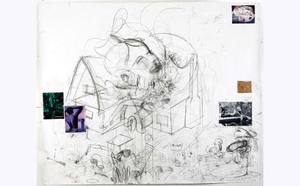The Ren: 100 Years of Cultivating the Arts


By FRANCK MERCURIO
In 1913 the International Exhibition of Modern Art made its way to Chicago from New York. Popularly known as the Armory Show, the exhibition introduced Chicagoans to the likes of Picasso, Matisse, Brancusi, and Kandinsky—and in the process, scandalized the public and many in the city’s conservative art circles.
Shortly thereafter, several arts organizations were formed, either in support of “the moderns” or in opposition to them. The Arts Club of Chicago, founded in 1916, had a decidedly modernist bent. The Renaissance Society, organized a year earlier in 1915 by a group of University of Chicago academics, was squarely in the other camp. The Society’s members aimed to “stimulate the love of the beautiful and to enrich the life of the community through the cultivation of the arts”—an idealized, 19th-century view of the function and societal role of art. During the first ten years, the organization reflected its scholarly origins by presenting a fairly sober roster of topics, such as “The Beginnings of Italian Sculpture” and “Chinese Paintings of the Tang, Sung, and Yuan Periods.”
But the Modernist movement could not be avoided forever.
Attitudes shifted in 1927 with the election of Agnes C. Gale, the Society’s first female president. She, along with succeeding president Eva Watson Schütze, brought modernism to the forefront of the Ren’s agenda. Writing in the Society’s 1929 bulletin, Schütze made her mission clear: “Part of the program of the Renaissance Society is to study the art of the present time, the new renaissance.”
Since then, there’s been no turning back. Over the years, the Ren has made its reputation by exhibiting intellectually challenging works by vanguard artists. This included a commitment to international, national, and local artists working in a variety of genres, from conceptual art to improvisational music to spoken word. The Society’s curators often worked alongside these artists to commission new pieces, something that helped distinguish the Ren from other arts institutions.
This fall, the Ren pays homage to its tradition of supporting cutting-edge art as it celebrates the Society’s 100th year with a program of special exhibitions and events titled Centennial. Included are shows featuring the work of Irena Haiduk, Wadada Leo Smith, and Paul McCarthy.
“All of these exhibitions have a very special role in our Centennial program,” says Solveig Øvstebø, the executive director and chief curator of the Renaissance Society. “The last show, Paul McCarthy, I think is an incredible, exciting presentation of his works.”
McCarthy is an LA-based multidisciplinary artist known mainly for his large-scale sculptures and installations. The Ren exhibition, titled Paul McCarthy: Drawings (opening November 8) will present two-dimensional works by the artist created for his White Snow project and subsequent installation, WS, exhibited at the Park Avenue Armory in 2013. The drawings reflect McCarthy’s intentions for his larger works and give insight into his creative process. The show is curated by Øvstebø along with guest curator Suzanne Ghez, the Ren’s former director.
Kicking off the Centennial celebration will be Irena “Ika” Haiduk’s Seductive Exacting Realism (opening September 10), a collaboration with the Istanbul Biennial. “Ika will present a completely new piece,” says Øvstebø. “Her work is very directly linked to socio-political discussions of our times.” According to the Ren’s website, the Chicago-based artist’s work will explore contemporary global politics through a “discursive data stream carrying a song in the form of a debate between two melodic voices.”
Indeed, the Ren has a long tradition of sponsoring and showcasing experimental music in addition to visual art. Ankrasmation: The Language Scores, 1967–2015 (opening October 11) features the work of musician, composer, educator, and artist Wadada Leo Smith. Curated by Hamza Walker (currently on sabbatical from the Ren) and John Corbett (of Corbett vs. Dempsey Gallery), the show complements the MCA’s The Freedom Principle: Experimentations in Art and Music, 1965 to Now.
In addition to its slate of exhibitions and programs, the Ren is using the Centennial as an opportunity to increase the Society’s visibility, especially here in the city.
“The thing with the Renaissance Society is that it has such a strong voice on the international landscape,” explains Øvstebø. “But I think more people should know this institution in Chicago.”
To that end, the Ren is unveiling a new graphic identity, new website, and even new signage that will help visitors better locate its home on the University of Chicago campus.
“People tell me that the Ren is a hidden gem,” says Director of Communications, Anna Searle Jones. “And I’m glad people think of us as a gem, but I don’t want us to be hidden. One of the aims of the Centennial is to make more people aware of what we do, that we’re free, and that we’re open to the public.”
CENTENNIAL EXHIBITIONS:
• Irena Haiduk: Seductive Exacting Realism - September 10-October 8, 2015
• Ian Wilson: Discussions - October 1 and 4, 2015
• Wadada Leo Smith: Ankhrasmation: The Language Scores, 1967–2015 - October 11 to 29, 2015
• John Knight, Museotypes at the Art Institute of Chicago - October 23 to November 29, 2015
• Paul McCarthy - November 8, 2015 to January 24, 2016
The public is invited to celebrate the Ren’s anniversary on Saturday, September 19, at the “100th Birthday Bash”.
Visit www.renaissancesociety.org for more details.
Top image: Paul McCarthy, Dwarf House, 2009, Pencil and collage on paper, 80” x 97”. Part of Paul McCarthy, on view November 8, 2015 to January 24, 2016





